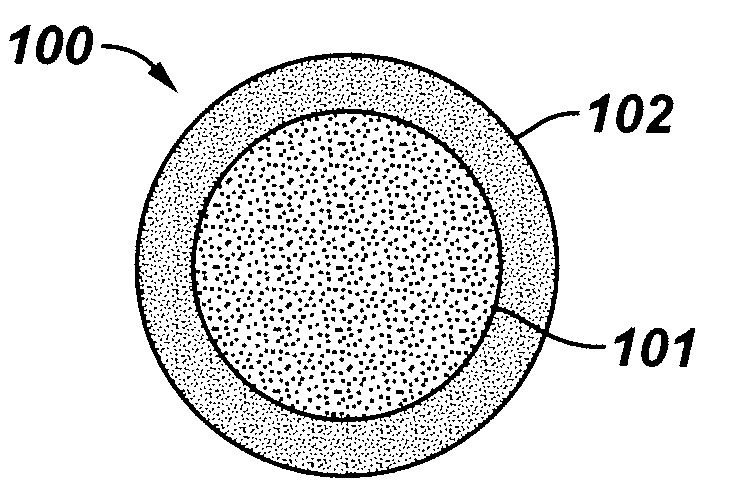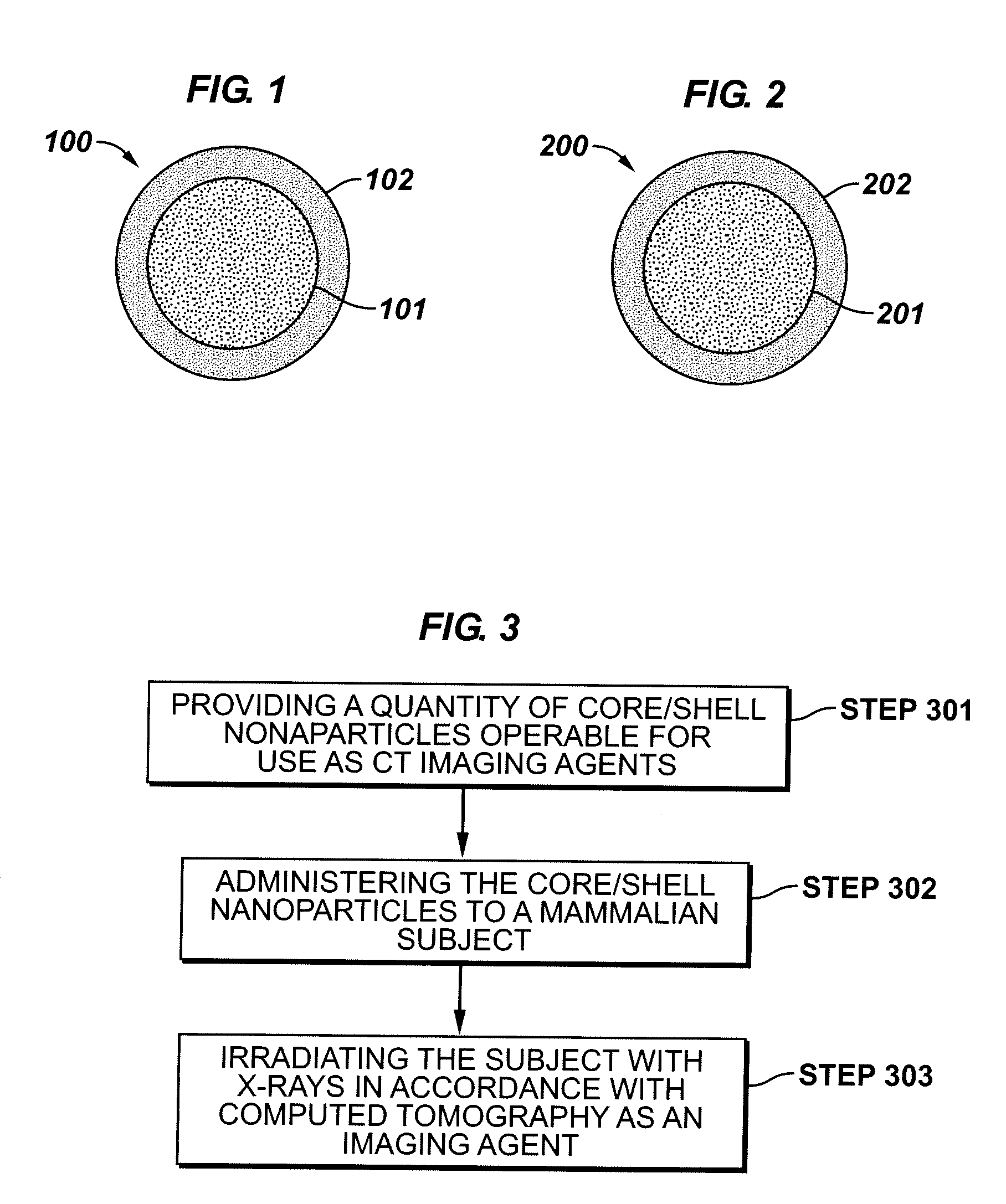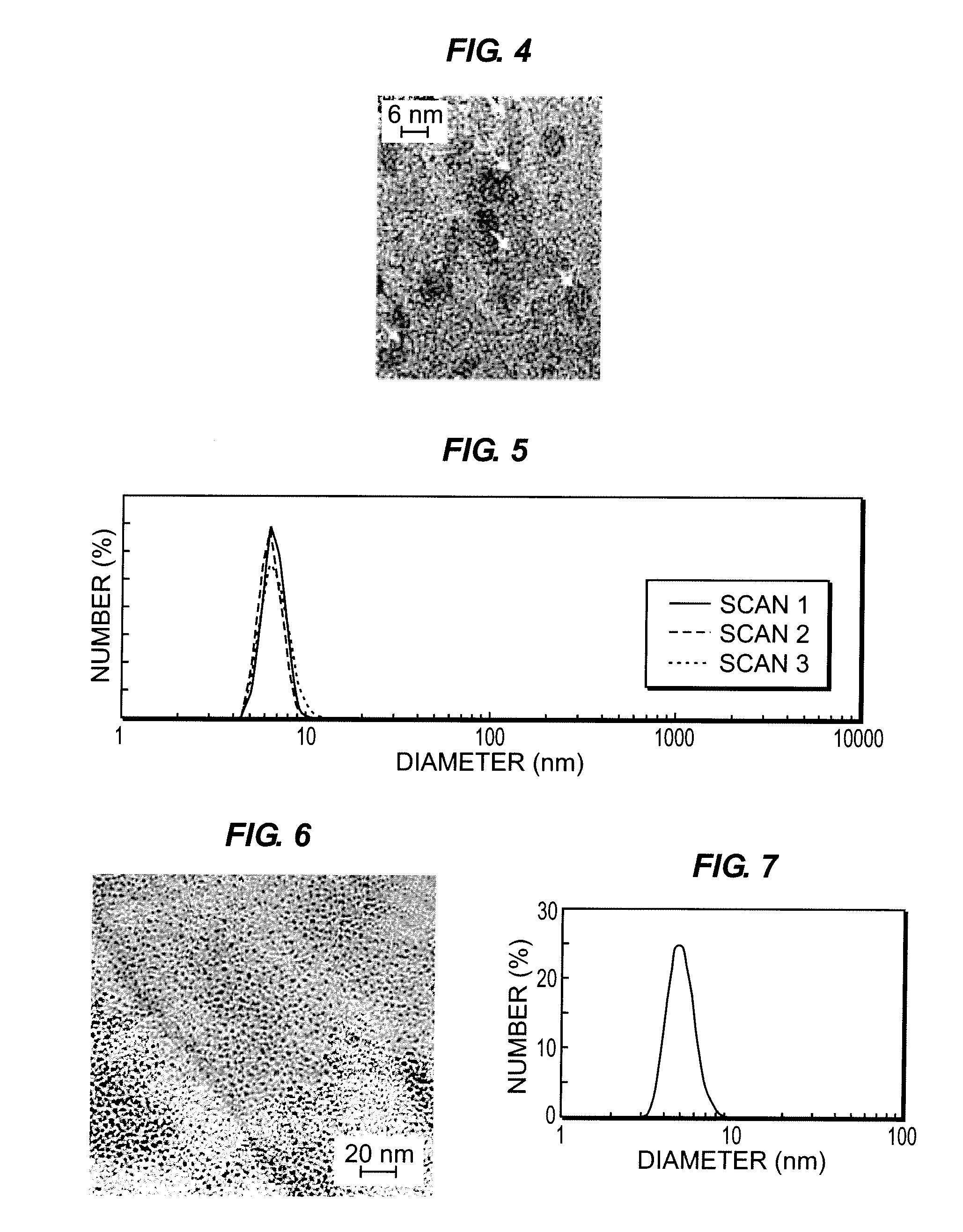Nanoparticle-based imaging agents for x-ray/computed tomography and methods for making same
- Summary
- Abstract
- Description
- Claims
- Application Information
AI Technical Summary
Benefits of technology
Problems solved by technology
Method used
Image
Examples
example 1
[0060]This Example serves to illustrate how a CT imaging agent can be prepared, in accordance with some embodiments of the present invention. In this particular Example, a passive shell is linked to an active core of hafnium oxide.
[0061]Hafnia nanocrystals (HfO2) were prepared from a suspension of hafnium oxychloride in ethanol. An organosilane-based coating was applied as follows: dilute 3-glycidoxypropyl(trimethoxysilane), GPTS was diluted using butanol (volume ratio 1:0.5) and pre-hydrolyzed step by addition of 0.1M HCl keeping the molar ratio of GPTS:H2O at 1:0.5. The resulting solution was subjected to vigorous stirring overnight at room temperature, then loaded with HfO2 nanocrystals. See Ribeiro et al., Appl. Phys. Lett. 2000, 77 (22), 3502-3504. FIG. 4 is a TEM image of active core / passive shell nanoparticles comprising a hafnium oxide core and polymeric shell, in accordance with some embodiments of the present invention.
example 2
[0062]This Example serves to illustrate how a CT imaging agent can be prepared, in accordance with some embodiments of the present invention. In this particular Example, a polymeric passive shell is linked to an active core of tantalum oxide. Further, in this particular Example, the shell formed about the core after the core is formed.
[0063]This example illustrates preparation of Ta2O5 nanoparticles for X-ray imaging: 34 ml of n-propanol, 0.44 ml isobutyric acid and 0.5 ml deuterium oxide were combined under nitrogen in the order specified and stirred for 30 minutes at room temperature. Tantalum ethoxide (1.87 g) was added in a drop-wise manner, albeit rapidly, and stirring continued under nitrogen for 18 hours. The tantalum ethoxide contains Ta(V), that is tantalum in the +5 valence state, a non-zero valence state. 2-[Methoxy(poly-ethylenoxy)propyl]trimethoxysilane (PEGsilane550, 4.832 g) was added to the stirred mixture as a 40 ml solution in n-propanol and the reaction was reflux...
example 3
[0065]This Example serves to illustrate how a CT imaging agent can be prepared, in accordance with some embodiments of the present invention. In this particular Example, a polymeric passive shell is linked to an active core of tantalum oxide. Further, in this particular Example, the shell formed about the core after the core is formed.
[0066]This example illustrates preparation of Ta2O5 nanoparticles for X-ray imaging: 34 ml of n-propanol, 0.44 ml isobutyric acid, and 0.5 ml deuterium oxide were combined under nitrogen in the order specified and stirred for 30 minutes at room temperature. Tantalum ethoxide (1.87 g) was added in a drop-wise manner, albeit rapidly, and stirring continued under nitrogen for 18 hours. The tantalum ethoxide contains Ta(V), that is tantalum in the +5 valence state, a non-zero valence state. Next, diethylphosphatoethyltriethoxysilane (PHS, 3 g) was added to the mixture as a 40 ml solution in n-propanol and the reaction was refluxed for 1.5 hours in air. Onc...
PUM
| Property | Measurement | Unit |
|---|---|---|
| Diameter | aaaaa | aaaaa |
| Diameter | aaaaa | aaaaa |
| Diameter | aaaaa | aaaaa |
Abstract
Description
Claims
Application Information
 Login to View More
Login to View More - R&D
- Intellectual Property
- Life Sciences
- Materials
- Tech Scout
- Unparalleled Data Quality
- Higher Quality Content
- 60% Fewer Hallucinations
Browse by: Latest US Patents, China's latest patents, Technical Efficacy Thesaurus, Application Domain, Technology Topic, Popular Technical Reports.
© 2025 PatSnap. All rights reserved.Legal|Privacy policy|Modern Slavery Act Transparency Statement|Sitemap|About US| Contact US: help@patsnap.com



